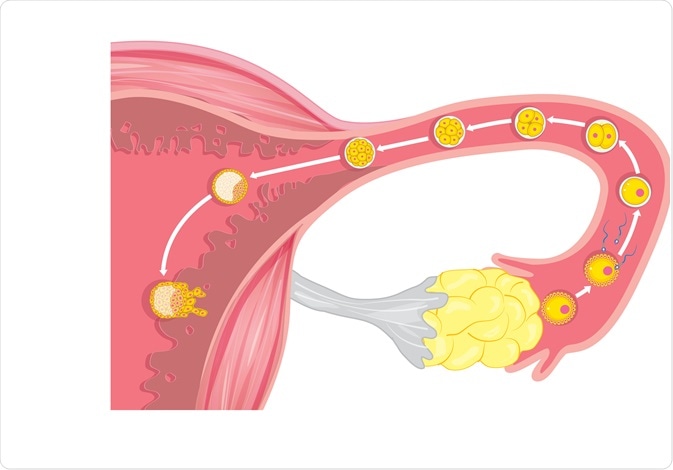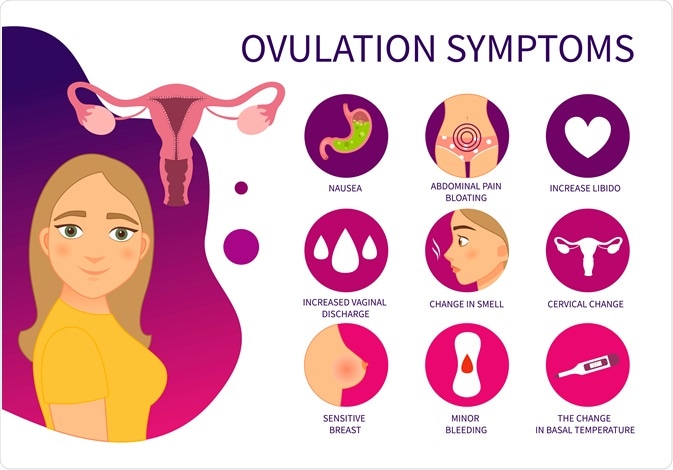Ovulation is the point in a woman’s menstruation cycle when the egg is released from the follicle in the ovaries and begins making its way down the fallopian tube to become fertilized.
Similar to the menstrual period itself, the intensity of the signs that indicate ovulation is occurring differ greatly between women. Some women tend to notice the signs easily whereas others may not notice them at all, as they are subtler.
The precise moment of ovulation has been photographed, which is a fascinating development for ovulatory research.
 Stages of ovulation. Image Credit: tanachai tantrakool / Shutterstock.com
Stages of ovulation. Image Credit: tanachai tantrakool / Shutterstock.com
Concealed ovulation
Humans are described to have a concealed ovulation, as people around the woman do not easily recognize the signs when she ovulates. This is in contrast to some animal species, that exhibit distinctive signs when they ovulate that indicate to the surrounding creatures that they are ovulating and fertile.
Despite human ovulation being described as concealed, the woman herself is often able to recognize certain signals and to determine the exact point of ovulation.
Cervical changes
The mucus produced by the cervix changes significantly throughout the menstrual cycle and particularly during the ovulatory period. Many women become familiar with these changes, which are often evident in the discharge from the vagina.
Body temperature
Prior to ovulation, the basal body temperature hovers around an average of 36.5. Just before ovulating, this drops slightly to 36.4 and then increases dramatically to 36.7 as ovulation occurs. This increase in basal body temperature is maintained until the end of the menstrual cycle.
Mittelschmerz
Mittelschmerz is literally translated from German to “middle pain” and refers to the lower abdominal pain associated with ovulation in the middle of the menstrual cycle. Approximately 1 in 5 women experience this sign to a noticeable extent, some every cycle and some occasionally.
Senses
Some women experience changes in senses around the time of ovulation and a heightened sense of smell is particularly common. Additionally, some women are able to sense the precise moment of ovulation as their body exhibits noticeable changes.
Libido
It is common for women to have increased sexual desire in the few days prior to ovulation. Women often feel more confident about the appearance of their body and one study found that women tend to improve facial attractiveness subtly approaching and during ovulation.
 Symptoms of ovulation. Image Credit: Igdeeva Alena / Shutterstock.com
Symptoms of ovulation. Image Credit: Igdeeva Alena / Shutterstock.com
Fertility awareness
Understanding the menstrual cycle and being able to recognize signs of ovulation can be very beneficial for a woman.
As fertility varies throughout the cycle, it is possible for a couple to use natural family planning techniques to time sexual intercourse according to the desired outcomes.
For those aiming to become pregnant, understanding when ovulation is about to occur is important because the woman is most likely to conceive when she has sex in the days just before ovulation. It is useful for many women to record the signs and body temperature to help them determine when they will ovulate, particularly if they are having difficulty conceiving.
Conversely, those wishing to avoid having a baby should practice safe methods of sex, especially so during the most fertile period before and during ovulation. Other methods of contraception are always recommended in addition, as natural family planning does not have a 100% success rate. However, awareness of ovulation and fertility can benefit women and it is worthwhile for them to understand the signs during this period.
References
Further Reading